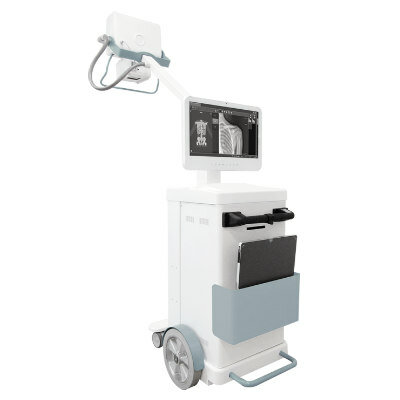Carestream Introduces Three-Dimensional Extension of General Radiography Through Its Digital Tomosynthesis Functionality
|
By MedImaging International staff writers Posted on 05 Dec 2019 |

Image: Digital Tomosynthesis (Photo courtesy of Carestream Health)
Carestream Health (Rochester, N.Y., USA) introduced a three-dimensional extension of general radiography through its Digital Tomosynthesis (DT) functionality at this year’s Radiological Society of North America (RSNA) conference.
Carestream is a worldwide provider of medical imaging systems; X-ray imaging systems for non-destructive testing; and precision contract coating services for a wide range of industrial, medical, electronic and other applications. At RSNA 2019, Carestream featured various medical imaging solutions, including its DT technology which is an upgradable option on the DRX-Evolution Plus System for simplifying workflow and reducing exam time. Carestream’s DT technique uses a single sweep of X-ray exposures and simplifies the operator’s workflow by separating the process of DT exposure acquisition from image volume formation. As a result, multiple projections are acquired during a single DT acquisition sweep. The exam time is greatly reduced with DT than with traditional tomography, doing away with the trial-and-error process in locating the anatomical region of interest. Post-processing, which relies on computer software, enables the generation of as many DT slices needed at varying intervals and thickness. The DT technique will roll out along with Carestream’s Dual-Energy technology which utilizes two filter materials that enable automatic switching between the high- and low-energy exposures to produce a soft-tissue-only image with the bone structures removed, as well as a corresponding bone-only image. This differential filter approach optimizes both X-ray spectrums, achieving optimal dose efficiency. It also delivers superior image quality—at the equivalent patient exposure as a standard, non-dual-energy posterior-anterior chest radiograph.
Carestream also featured its new Focus 35C digital radiography (DR) detector with Image Suite Software that offers a budget-friendly way to tap the power of digital medical imaging. The economical retrofit solution is powered by Carestream’s Eclipse image processing engine and combines advanced image processing with broad functionality, easily transforming an analog X-ray room into digital. The enhanced software was designed with smaller facilities in mind to increase efficiency while offering a simple intuitive user interface and automated workflow. The Focus 35C Detector and Image Suite Software provide a streamlined workflow along with a complete image acquisition, management and archive system.
Carestream’s featured products at RSNA 2019 also included the OnSight 3D Extremity System which uses cone beam CT technology to capture high-quality, 3D weight-bearing and non weight-bearing upper and lower extremity exams; the DRX-Excel Plus which combines fluoroscopy and general radiology capabilities into one compact unit with accelerated workflow, high-resolution images, and easy convenient operation to provide total flexibility; the DRX-Evolution Plus which delivers a full range of features and options that make it more powerful, more dependable and more affordable than ever; the DRX-Revolution mobile X-ray system featuring excellent image quality and maneuverability; the DRX-Revolution Nano, a fully integrated DR solution that can speed workflow, boost productivity, and improve standard of care; and its X-Factor wireless, shareable DR detectors.
Related Links:
Carestream Health
Carestream is a worldwide provider of medical imaging systems; X-ray imaging systems for non-destructive testing; and precision contract coating services for a wide range of industrial, medical, electronic and other applications. At RSNA 2019, Carestream featured various medical imaging solutions, including its DT technology which is an upgradable option on the DRX-Evolution Plus System for simplifying workflow and reducing exam time. Carestream’s DT technique uses a single sweep of X-ray exposures and simplifies the operator’s workflow by separating the process of DT exposure acquisition from image volume formation. As a result, multiple projections are acquired during a single DT acquisition sweep. The exam time is greatly reduced with DT than with traditional tomography, doing away with the trial-and-error process in locating the anatomical region of interest. Post-processing, which relies on computer software, enables the generation of as many DT slices needed at varying intervals and thickness. The DT technique will roll out along with Carestream’s Dual-Energy technology which utilizes two filter materials that enable automatic switching between the high- and low-energy exposures to produce a soft-tissue-only image with the bone structures removed, as well as a corresponding bone-only image. This differential filter approach optimizes both X-ray spectrums, achieving optimal dose efficiency. It also delivers superior image quality—at the equivalent patient exposure as a standard, non-dual-energy posterior-anterior chest radiograph.
Carestream also featured its new Focus 35C digital radiography (DR) detector with Image Suite Software that offers a budget-friendly way to tap the power of digital medical imaging. The economical retrofit solution is powered by Carestream’s Eclipse image processing engine and combines advanced image processing with broad functionality, easily transforming an analog X-ray room into digital. The enhanced software was designed with smaller facilities in mind to increase efficiency while offering a simple intuitive user interface and automated workflow. The Focus 35C Detector and Image Suite Software provide a streamlined workflow along with a complete image acquisition, management and archive system.
Carestream’s featured products at RSNA 2019 also included the OnSight 3D Extremity System which uses cone beam CT technology to capture high-quality, 3D weight-bearing and non weight-bearing upper and lower extremity exams; the DRX-Excel Plus which combines fluoroscopy and general radiology capabilities into one compact unit with accelerated workflow, high-resolution images, and easy convenient operation to provide total flexibility; the DRX-Evolution Plus which delivers a full range of features and options that make it more powerful, more dependable and more affordable than ever; the DRX-Revolution mobile X-ray system featuring excellent image quality and maneuverability; the DRX-Revolution Nano, a fully integrated DR solution that can speed workflow, boost productivity, and improve standard of care; and its X-Factor wireless, shareable DR detectors.
Related Links:
Carestream Health
Latest RSNA 2019 News
- Lunit Demonstrates Latest Updated AI Solutions for Chest and Breast Radiology at RSNA 2019
- Bracco Diagnostics Unveils Contrast Media and Device Offerings at RSNA 2019
- Guerbet Showcases New Dose&Care and Other Digital Solutions with Diagnostic and Interventional Imaging Offerings
- Canon Introduces New Wireless Detectors and Digital PET/CT Scanner at RSNA 2019
- Siemens Healthineers Introduces SOMATOM On.site Mobile Head CT Scanner and AI-based MRI Assistants at RSNA
- Hologic Launches Unifi Workspace, Comprehensive Reading Solution for Breast Health Diagnostics
- Agfa Launches New Groundbreaking Digital Radiography Unit at RSNA 2019
- Fujifilm SonoSite Exhibits Complete Point-of-Care Ultrasound Portfolio at RSNA 2019
- Fujifilm Previews World's First Glass-Free Digital Radiography Detector at RSNA 2019 Image
- NVIDIA Showcases Latest AI-driven Medical Imaging Advancements at RSNA 2019
- Philips Healthcare Demonstrates How AI Breast Software Brings Intelligence and Automation to Breast Ultrasound
- Siemens Healthineers Focuses on Digital Transformation of Imaging and Therapy at RSNA 2019
Channels
Radiography
view channel
Novel Breast Imaging System Proves As Effective As Mammography
Breast cancer remains the most frequently diagnosed cancer among women. It is projected that one in eight women will be diagnosed with breast cancer during her lifetime, and one in 42 women who turn 50... Read more
AI Assistance Improves Breast-Cancer Screening by Reducing False Positives
Radiologists typically detect one case of cancer for every 200 mammograms reviewed. However, these evaluations often result in false positives, leading to unnecessary patient recalls for additional testing,... Read moreMRI
view channel
PET/MRI Improves Diagnostic Accuracy for Prostate Cancer Patients
The Prostate Imaging Reporting and Data System (PI-RADS) is a five-point scale to assess potential prostate cancer in MR images. PI-RADS category 3 which offers an unclear suggestion of clinically significant... Read more
Next Generation MR-Guided Focused Ultrasound Ushers In Future of Incisionless Neurosurgery
Essential tremor, often called familial, idiopathic, or benign tremor, leads to uncontrollable shaking that significantly affects a person’s life. When traditional medications do not alleviate symptoms,... Read more
Two-Part MRI Scan Detects Prostate Cancer More Quickly without Compromising Diagnostic Quality
Prostate cancer ranks as the most prevalent cancer among men. Over the last decade, the introduction of MRI scans has significantly transformed the diagnosis process, marking the most substantial advancement... Read moreUltrasound
view channel
Deep Learning Advances Super-Resolution Ultrasound Imaging
Ultrasound localization microscopy (ULM) is an advanced imaging technique that offers high-resolution visualization of microvascular structures. It employs microbubbles, FDA-approved contrast agents, injected... Read more
Novel Ultrasound-Launched Targeted Nanoparticle Eliminates Biofilm and Bacterial Infection
Biofilms, formed by bacteria aggregating into dense communities for protection against harsh environmental conditions, are a significant contributor to various infectious diseases. Biofilms frequently... Read moreNuclear Medicine
view channel
New SPECT/CT Technique Could Change Imaging Practices and Increase Patient Access
The development of lead-212 (212Pb)-PSMA–based targeted alpha therapy (TAT) is garnering significant interest in treating patients with metastatic castration-resistant prostate cancer. The imaging of 212Pb,... Read moreNew Radiotheranostic System Detects and Treats Ovarian Cancer Noninvasively
Ovarian cancer is the most lethal gynecological cancer, with less than a 30% five-year survival rate for those diagnosed in late stages. Despite surgery and platinum-based chemotherapy being the standard... Read more
AI System Automatically and Reliably Detects Cardiac Amyloidosis Using Scintigraphy Imaging
Cardiac amyloidosis, a condition characterized by the buildup of abnormal protein deposits (amyloids) in the heart muscle, severely affects heart function and can lead to heart failure or death without... Read moreGeneral/Advanced Imaging
view channel
New AI Method Captures Uncertainty in Medical Images
In the field of biomedicine, segmentation is the process of annotating pixels from an important structure in medical images, such as organs or cells. Artificial Intelligence (AI) models are utilized to... Read more.jpg)
CT Coronary Angiography Reduces Need for Invasive Tests to Diagnose Coronary Artery Disease
Coronary artery disease (CAD), one of the leading causes of death worldwide, involves the narrowing of coronary arteries due to atherosclerosis, resulting in insufficient blood flow to the heart muscle.... Read more
Novel Blood Test Could Reduce Need for PET Imaging of Patients with Alzheimer’s
Alzheimer's disease (AD), a condition marked by cognitive decline and the presence of beta-amyloid (Aβ) plaques and neurofibrillary tangles in the brain, poses diagnostic challenges. Amyloid positron emission... Read more.jpg)
CT-Based Deep Learning Algorithm Accurately Differentiates Benign From Malignant Vertebral Fractures
The rise in the aging population is expected to result in a corresponding increase in the prevalence of vertebral fractures which can cause back pain or neurologic compromise, leading to impaired function... Read moreImaging IT
view channel
New Google Cloud Medical Imaging Suite Makes Imaging Healthcare Data More Accessible
Medical imaging is a critical tool used to diagnose patients, and there are billions of medical images scanned globally each year. Imaging data accounts for about 90% of all healthcare data1 and, until... Read more
Global AI in Medical Diagnostics Market to Be Driven by Demand for Image Recognition in Radiology
The global artificial intelligence (AI) in medical diagnostics market is expanding with early disease detection being one of its key applications and image recognition becoming a compelling consumer proposition... Read moreIndustry News
view channel
Bayer and Google Partner on New AI Product for Radiologists
Medical imaging data comprises around 90% of all healthcare data, and it is a highly complex and rich clinical data modality and serves as a vital tool for diagnosing patients. Each year, billions of medical... Read more






















